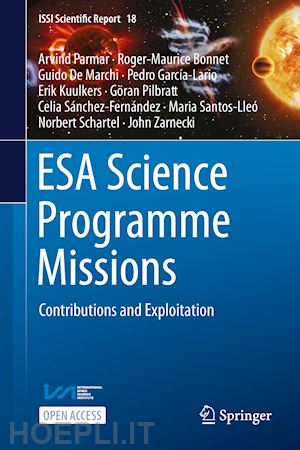

Questo prodotto usufruisce delle SPEDIZIONI GRATIS
selezionando l'opzione Corriere Veloce in fase di ordine.
Pagabile anche con Carta della cultura giovani e del merito, 18App Bonus Cultura e Carta del Docente
This work got its start by trying to answer the question "how do you evaluate the scientific performance of the ESA's Science Programme missions?" For many years, the decision makers responsible for the content of the ESA Science Programme have been provided with information for each mission including, but not limited to, the number of publications published, the number of publications that are highly cited, the total number of citations used, various statistical metrics and the number of unique author names. However, this reporting only provides snapshots of these missions and was not widely distributed.
In this book, we report on a systematic study of these metrics and their evolution with time to provide insights into mission successes and the communities exploiting the data provided by the Science Programme’s missions. In addition, we examine the outcomes of the announcements of observing opportunities for ESA’s observatory missions, INTEGRAL, Herschel and XMM-Newton to provide insights into the evolutions of the user communities with time, location and gender.
Finally, we examine the provision of payload elements for ESA’s Science Programme missions. We use the number of payload investigators to give insights into the levels of contribution and exploitation of the different ESA Member States.
This book is open access under a CC BY license.
1 The ESA Science Programme.- 2 ESA Mission Publications and Their Impact.- 3 Payload Provision to the ESA Science Programme.- 4 XMM-Newton Observing Time Proposals.- 5 INTEGRAL Observing Time Proposals.- 6 Herschel Observing Time Proposals.- 7 Conclusions.
Dr. Parmar obtained his PhD in X-ray astronomy in 1981 from MSSL, University College London (UCL). He joined ESA in 1982 to work on the EXOSAT mission before becoming the study and project scientist and instrument and mission manager for a number of high-energy astronomy missions. In 2009 he became Head of ESA’s Astronomy Science Operations Division. Between 2012 and 2020 he was the ESA Coordinator for Astronomy and Fundamental Physics. From 2013-2020 he combined this position with being the Head of the ESA Science Support Office, which is the home of ESA’s Science Directorate study and project scientists. In 2020, he retired from ESA. In 2023 he was awarded an honorary professorship at UCL and in 2024 he became the treasurer of the Royal Astronomical Society. He has 408 scientific publications of which 181 are peer reviewed with 13,400 citations.











Il sito utilizza cookie ed altri strumenti di tracciamento che raccolgono informazioni dal dispositivo dell’utente. Oltre ai cookie tecnici ed analitici aggregati, strettamente necessari per il funzionamento di questo sito web, previo consenso dell’utente possono essere installati cookie di profilazione e marketing e cookie dei social media. Cliccando su “Accetto tutti i cookie” saranno attivate tutte le categorie di cookie. Per accettare solo deterninate categorie di cookie, cliccare invece su “Impostazioni cookie”. Chiudendo il banner o continuando a navigare saranno installati solo cookie tecnici. Per maggiori dettagli, consultare la Cookie Policy.